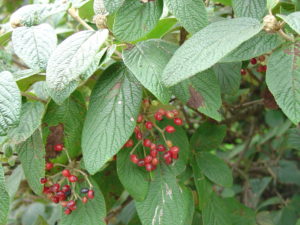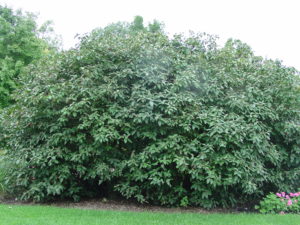Alleghany viburnum (Viburnum x rhytidophylloides ‘Alleghany’) aka lantanaphyllum viburnum, is a large easy to grow semi-evergreen (USDA hardiness zones 5-8). It will grow to about 10-12 feet tall and a spread of 12 feet at maturity. This low maintenance shrub is a hybrid cross between V. rhytidophyllum and V. lantana ‘Mohican’. The cross was made in the Netherlands in 1925 and released by U.S. National Arboretum in 1966.
Its leathery dark green leaves are resistant to bacterial leaf spot. Its stiff upright branches are coated with woolly gray-brown hairs on stems and on the undersides of leaves. Its semi-evergreen foliage makes it an excellent choice for privacy screening. Foliage is evergreen in the South.
In most years leaves turn purplish in winter and persist through ice and snow through late February. In mid-spring, showy creamy white flat-top flowers open at the ends of branches. Upclose, flowers emit an unpleasant stale fragrance. When adequately pollinated from other viburnum species planted nearby, spectacular clusters of dark red fruits are produced from late summer to early fall that look great against the coarse green foliage. Red fruits ripen to black and attract numerous birds.
Alleghany viburnum grows well in any soil as long as it is drains adequately. Sun to part shade sites are preferred. Flowers are more plentiful in full sun. Feed with a slow release fertilizer such as Osmocote™ or Nutrikote™ in early spring as leaves emerge.
Alleghany viburnum is rated a four-star landscape shrub, with multiple season assets including beautiful semi-evergreen leathery foliage, dependable flowering, and showy fruits in fall and winter. Established shrubs are highly drought tolerant. In early spring rake away old leaves and mulch viburnums for a clean appearance. This viburnum has no serious insect or disease problems.
Prune as needed immediately after flowering because next year’s flower buds form in summer. Best fruit set occurs with cross pollination from parents or clones of the within hybrid.



 Posted in
Posted in 
